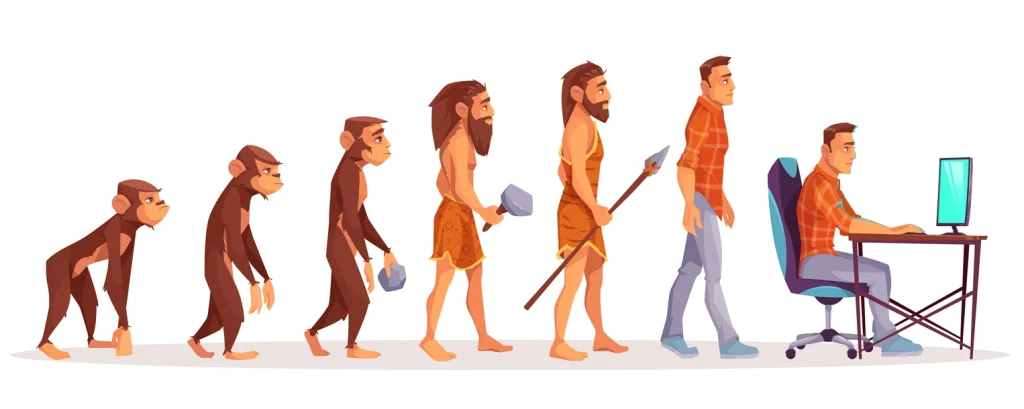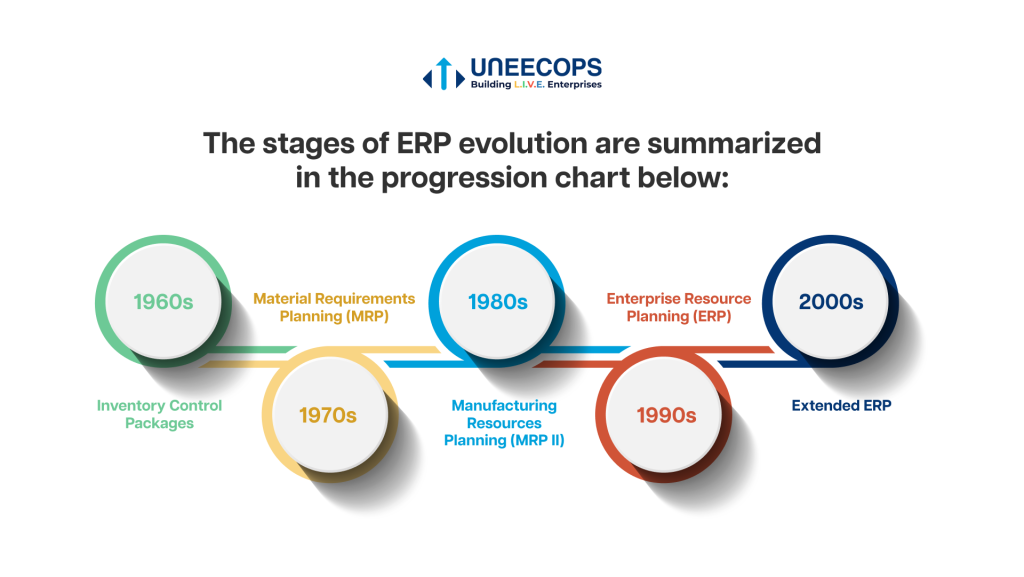“It’s not the strongest of the species that survives, not the most intelligent that survives. It is the one most adaptable to change.” – Charles Darwin
And that’s evolution in its truest sense.
Human evolution is a testament to our species’ adaptability and innovation over millennia, marked by the gradual development of bipedalism, larger brains, and complex social structures. Similarly, the evolution of ERP (Enterprise Resource Planning) systems mirrors this trajectory, as businesses have evolved from manual processes to sophisticated digital platforms. Both human and ERP evolution highlight the relentless pursuit of efficiency and advancement, showcasing our innate drive to optimize and thrive in ever-changing environments.
But how did all this begin? Let’s trace the history of ERP, stages of ERP evolution, evolution of ERP system and ERP expansion.

Tracing the Lineage: Evolution of ERP
The exponential growth of ICT (information and communication technologies), propelled by microelectronics, computer hardware, and software systems, has profoundly impacted computing applications across all organizational domains. As businesses navigated an increasingly intricate landscape characterized by heightened inter-functional data exchange for decision-making, streamlined procurement, inventory management, and distribution, efficient information systems became paramount.
In the 1960s, organizations primarily relied on centralized computing systems and inventory control packages (IC) to automate inventory management, leveraging programming languages like COBOL, ALGOL, and FORTRAN. Subsequently, in the 1970s, material requirements planning (MRP) systems emerged, focusing on product and parts planning according to the master production schedule.
In the 1980s, the evolution of ERP systems advanced with the introduction of manufacturing resources planning (MRP II) systems. These systems focused on automating manufacturing processes with shop floor and distribution visibility, project management, finance and engineering tracking. Finally, ERP systems debuted in the late 1980s and early 1990s, revolutionizing enterprise-wide coordination and integration across functions.
Built on the tech underpinnings of MRP and MRP II, ERP systems seamlessly integrate diverse business processes, spanning manufacturing, accounting, distribution, finance, project management, inventory automation and more. This integration enhances accessibility, visibility, and consistency throughout the enterprise.
Yet, ERP vendors and customers confront new challenges amidst the rapid evolution of computing power and the ubiquitous Internet. The imperative to transcend proprietary constraints and embrace collaborative enterprise models across intranets, extranets, and the Internet compels a paradigm shift. The advent of “add-on” modules signals a proactive response by ERP vendors to these evolving dynamics. It’s an ongoing journey of reengineering and innovation, driving the continuous evolution of ERP systems.
Throughout the 1990s, the continuous evolution of ERP occurred. Vendors constantly enhanced their offerings by introducing additional ERP expansion modules and functionalities as “add-ons” to the core modules, leading to “extended ERPs.”
The stages of ERP evolution are summarized in the progression chart below:
1960s – Inventory Control Packages
1970s – Material Requirements Planning (MRP)
1980s – Manufacturing Resources Planning (MRP II)
1990s – Enterprise Resource Planning (ERP)
2000s – Extended ERP
Now, let us talk about the present. In fact, the evolution of ERP is happening in its real sense every passing decade.

Evolution of ERP System in 2000s and 2010s
2000s-2010s: In 2000, Gartner introduced ERP II, marking a pivotal moment in the evolution of enterprise resource planning. This internet-enabled software provided real-time access to ERP solutions, expanding functionality beyond core front-to-back integration. With features such as customer relationship management (CRM), business intelligence, e-commerce, supply chain management (SCM), and human capital management (HCM), ERP II represented a significant advancement. By incorporating more information into the ERP system, users gained enhanced agility in responding to changes in demand, industry trends, and opportunities for improvement.
2010 – Present: The emergence of sophisticated technologies and data storage has paved the way for cloud-based ERP solutions, gaining momentum in recent years. Operating on a Software as a Service (SaaS) model, cloud-based ERP eliminates the need for companies to invest in and maintain hardware infrastructure, reducing reliance on IT personnel and simplifying implementation processes. This shift represents a notable improvement over traditional On-Premises systems, granting businesses access to data via the web from any device with an internet connection.
The history of ERP says it loud and clear – the tech software has come a long way.
Today, ERP is on Cloud
Once, legacy systems reigned supreme in the world of enterprise resource planning (ERP). These systems were meticulously designed to integrate various functions within a company’s walls. However, a new era dawned as technology advanced. It brought the stages of ERP evolution into its last leg, “ERP expansion.”
Then came the on-premises systems, where businesses were tasked with managing their own software on dedicated equipment. This meant purchasing servers, configuring software, and handling in-house security, backups, and data privacy. While effective, this approach came with hefty financial and resource burdens. Nowadays, on-prem is also the history of ERP.
But then, a revolutionary concept emerged – Cloud ERP. Unlike its predecessors, Cloud ERP offered comparable functionalities at a fraction of the cost. By harnessing the power of the public cloud model, costs could be distributed among multiple users, making it a budget-friendly option for businesses of all sizes.
In the Software as a Service (SaaS) time, servers were deployed on the cloud, enabling users to access the system via the internet and pay a subscription fee. This breakthrough democratized ERP solutions, granting small and midsize businesses access to the same benefits enjoyed by their larger counterparts.
Today, with cloud software, the burden of managing physical hardware and servers has shifted from businesses to software vendors. This allows companies to focus on leveraging the advantages of ERP – automated processes, improved data accuracy, and enhanced efficiency – without the hassle of infrastructure management.
In this new era of Cloud ERP, businesses are empowered to thrive in a digital landscape where innovation knows no bounds. And so, the journey towards greater agility, scalability, and success continued, fueled by the transformative power of cloud technology.
But this is not the end of the story. It’s in fact, the beginning of a new, more evolved, more modern system.
The Future of ERP: AI-Powered, Insight-Fueled, Intelligence-Driven!
The future of ERP systems unfolds with a dynamic tapestry of trends, shaping the landscape for 2023 and beyond:
Cloud dominance: The meteoric rise of Cloud ERP continues unabated, with global adoption poised to nearly double by 2027. Driven by the imperative for digital transformation and enhanced business capabilities, cloud solutions offer agility and scalability vital for today’s rapidly evolving industries.
Mobile evolution: Mobile ERP evolves into sophisticated multi-device experiences, seamlessly integrating tasks across various platforms. From smartphones to smartwatches, users enjoy a seamless workflow, accessing ERP functionalities wherever they go.
AI and IoT integration: Artificial intelligence and the Internet of Things (IoT) converge with ERP, unlocking a realm of possibilities. From predictive analytics to real-time monitoring, ERP harnesses the power of AI and IoT to drive efficiency and innovation.
Enhanced analytics: ERP analytics transcend traditional reporting, offering AI-powered insights and conversational interfaces. From predictive forecasting to proactive anomaly detection, ERP analytics empower users with actionable intelligence.
Personalized and adaptative ERP: ERP solutions evolve towards greater personalization, tailoring experiences to individual user needs. With adaptive interfaces and low-code customization, ERP becomes a bespoke tool for enhancing productivity.
Composable ERP: Composable ERP enables agile business adaptation, allowing organizations to assemble tailored solutions for specific needs. With the ability to re-compose business operations as conditions change, companies gain unprecedented agility and resilience.
Industry clouds: Industry clouds emerge as tailored solutions for vertical-specific requirements, offering adaptability and innovation. Combining ERP with industry-specific functionalities, businesses secure a competitive advantage within their respective markets.
As we journey into the future of ERP, one thing is sure shot: change is inevitable.
And, we are again reminded of the timeless wisdom of Charles Darwin, from where we began. No wonder, innovation, adaptability and intelligence are the cornerstones of survival and success.
Embracing change, innovating boldly, and leveraging the transformative power of ERP trends, organizations can chart a course toward resilience and growth in the dynamic years ahead.







